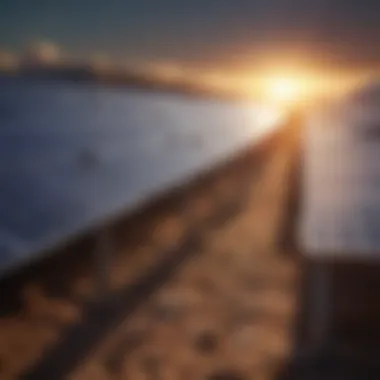Analyzing the Shifting Costs of Solar Panels Over the Years


Intro
The landscape of solar panel costs has undergone a significant transformation over the years, painting a vivid picture of technological advancements, market dynamics, and environmental considerations. Understanding these shifting costs is essential for anyone seeking to invest in solar energy. It's not just about the panels themselves; various factors come into play, influencing prices in ways that might not be immediately apparent.
In this exploration, we aim to break down the evolution of solar panel costs, from their early days to the present. This narrative doesn't just serve to inform; it’s designed to empower readers, helping them grasp the intricacies of solar energy investments. With a combination of historical context, market influences, and future projections, we will offer a robust framework for understanding the economic landscape surrounding solar energy.
By delving into the key terms and expert insights, we'll equip both novice and seasoned investors with the knowledge needed to navigate the solar market confidently.
Investment Terminology
Understanding the lingo can be just as crucial as recognizing the figures. Let’s explore some of the key terms and relevant acronyms that frequently pop up in discussions about solar panel investments and pricing trends.
Key Terms and Definitions
- Solar Panel Cost: Refers to the total price of purchasing and installing solar panels, inclusive of equipment and labor.
- Levelized Cost of Energy (LCOE): This metric allows investors to evaluate the lifetime costs of generating energy from solar panels, typically expressed in cents per kilowatt-hour (kWh).
- Payback Period: The duration it takes for the savings on electricity bills to cover the initial investment in solar panel systems.
Common Acronyms in Finance
- ROI: Return on Investment, a measure used to evaluate the efficiency of an investment.
- PV: Photovoltaic, which refers to the solar panels that convert sunlight into electricity.
- KWh: Kilowatt-hour, a common unit of energy used to measure electricity consumption.
Each term holds its unique place, shaping the dialogue around solar energy investment. Knowing what these terms mean will provide a solid foundation as we navigate this vibrant yet complex field.
Expert Insights
In addition to understanding the terminology, learning from those who have traversed this path can enhance our strategic approach.
Investment Strategies Overview
Drawing from seasoned investors and financial analysts, some highlighted strategies emerge:
- Diversification: Consider broadening your portfolio to include energy efficiency upgrades alongside solar investments to mitigate risk.
- Long-Term Planning: View solar energy adoption through the lens of long-term savings rather than immediate costs. The market is dynamic, and prices can shift dramatically.
- Federal and State Incentives: Stay informed about available subsidies and tax incentives that can significantly reduce upfront costs. These incentives vary widely by region and can be a game-changer for your investment.
Tips from Financial Advisors
Financial advisors with experience in renewable energy provide valuable suggestions:
- Conduct Thorough Research: Understand the local market dynamics and technological advancements to find the best deals.
- Consult with Experts: Don’t shy away from seeking advice or a second opinion on solar options and energy efficiency programs. Experts can offer insights tailored to your specific situation.
- Consider Market Trends: Watch for emerging technologies that could influence pricing or efficiency, such as advancements in battery storage or panel technology.
"Investing in solar today is not merely about the upfront costs; it's about securing your energy future and embracing a sustainable lifestyle."
Gaining insight into both the terminology and expert strategies equips potential investors with the tools necessary for informed decision-making. As we move forward, we’ll delve deeper into how historical trends and current market dynamics play pivotal roles in shaping solar panel costs.
Prologue to Solar Panel Economics
Understanding the economic landscape surrounding solar panels is crucial for comprehending both their affordability and value proposition in today's energy markets. Solar energy, as a renewable alternative, has evolved significantly, influenced by myriad factors like technological advancement, policy changes, and market demands. This article aims to shed light on the economic factors at play, ultimately helping consumers and investors make informed decisions in the solar energy sphere.
As we delve into this subject matter, we will highlight the significance of cost analysis within the realm of solar technologies. A thorough grasp of how prices have shifted over the years offers insight not just into affordability, but also into the investment potential of solar systems.
Understanding Solar Panels
At its core, a solar panel converts sunlight into electricity. The technology has progressed from bulky, inefficient models to streamlined, effective units capable of significant energy production. It’s akin to moving from a clunky old car to a sleek, fast electric vehicle. Modern panels now boast enhanced efficiency levels, which play a vital role in their overall cost-effectiveness.
The two primary types of solar panels are monocrystalline and polycrystalline. Monocrystalline panels are often more efficient, but they come with a heftier price tag. On the other hand, while polycrystalline panels are generally cheaper, their performance can be slightly less impressive. Thus, understanding the specifications and nuances between these options is critical for buyers.
Importance of Cost Analysis
The financial aspect of solar energy cannot be overstated. A comprehensive cost analysis allows potential adopters to gauge the investment's merit.
Here are some essential points regarding the importance of cost analysis:
- Informed Decision-Making: Knowledge of historical prices and trends can empower consumers and investors to make educated choices regarding the purchase and installation of solar panels.
- Budget Planning: Understanding how much one might spend helps in planning for installation costs and anticipating when savings will balance the initial investment.
- Return on Investment (ROI): Evaluating costs against potential savings on electricity bills plays an essential role in determining the panel's long-term value, making it crucial to factor this into any analysis.
- Market Trends Awareness: Keeping tabs on the evolving market helps predict future shifts in costs, enhancing the ability to time a purchase optimally.
"Cost analysis is not just about numbers; it's about understanding how those numbers influence the overall value of your investment, can help identify trends that impact future prices, and guide decisions that could lead to a sustainable energy future."


Historical Overview of Solar Panel Prices
The historical overview of solar panel prices offers a compelling narrative that traces the technological evolution, market reactions, and regulatory shifts influencing the cost of solar energy systems. Understanding this timeline is essential for anyone contemplating an investment in solar; it provides context regarding how and why solar panel prices have shifted over the years. In a landscape previously dominated by high costs and skepticism, the changes we observe now reflect not just advances in technology but also changing public policy and consumer attitudes towards renewable energy.
Cost Trends in the Early Years
In the early days of solar energy adoption, costs were nothing short of astronomical. The solar panel market in the 1970s and 1980s was characterized by limited production capabilities and relatively low demand. As a result, prices were steep, often seen as a luxury for forward-thinking individuals rather than a practical solution for the average consumer.
The price of solar panels in the 1980s often reached upwards of $76 per watt, a staggering figure that illustrates why solar energy was largely sidelined compared to traditional energy sources. These high costs were partly due to the materials used, such as silicon, which was costly at the time. Moreover, the production was minimal, leading to reduced economies of scale.
Technological Advances and Their Impact
Fast forward to the late 1990s and early 2000s, where technology began pushing the envelope. Innovations like thin-film technology and improvements in crystalline silicon processes opened the door for more efficient and cheaper solar panels. This marked a turning point; manufacturers began focusing on streamlined production techniques that significantly brought down costs.
The efficiency of solar cells improved, allowing panels to capture more sunlight without a proportional increase in price. By 2010, we saw the price drop to about $3 per watt. The technological advancements also included better energy storage solutions accompanying these improvements, creating a more comprehensive solar power system that appealed to businesses and homeowners alike.
Market Influences from Policy Changes
Just as vital as technological leaps were the government interventions and policy changes that impacted market dynamics. Through incentives and rebates, governments around the world gradually stimulated the solar market. Programs aimed at reducing fossil fuel dependency and promoting renewable energy significantly contributed to demand. In the United States, for instance, tax credits for solar installations lowered the financial burden, making solar more accessible.
These policy shifts created a ripple effect, drawing in more investments and enticing manufacturers to enter the market. With heightened competition came even further cost reductions, establishing solar energy as a viable alternative to conventional energy sources.
"Government incentives were crucial in making solar affordable, bridging the gap between innovative technology and consumer access."
As we analyze the costs and trends associated with solar panel prices, it's clear that navigating the history of this technology is invaluable. Understanding the interplay between technology, economics, and policy equips potential investors with the knowledge needed to predict future trends, as the market continues to evolve.
Key Factors Affecting Solar Panel Costs
Understanding the various elements that influence solar panel costs is crucial for anyone considering an investment in solar energy. It's not merely about the purchase price. The factors that dictate these costs can significantly impact long-term returns and overall efficiency. In essence, when you dig deeper into these layers, you uncover the complex web of economics that dictates solar energy's viability in different settings.
There are three main elements that really play a role in this equation: material costs and supply chain dynamics, labor costs and installation variables, and economies of scale in manufacturing. Each of these aspects intertwines, producing a distinct effect on the overall expenses associated with solar panel investment.
Material Costs and Supply Chain Dynamics
Material costs represent a significant chunk of the initial investment in solar panels. This includes raw materials like silicon, glass, and metals such as aluminum and copper. Over the past years, the prices of these materials can fluctuate due to various reasons, such as mining disruptions or shifts in international trade policies.
"Supply chain dynamics" also come into play. If there's a part of the supply chain that gets held up—be it through transport issues or scarcity of components—this can lead to increased costs that manufacturers eventually pass on to consumers. The modern global economy means that disruptions in one part of the world can ripple through to affect prices elsewhere.
When manufacturing is heavily dependent on specific materials, as it is with solar panels, even minor changes can cause major impacts. This is something potential investors should keep a keen eye on. If you're considering solar, it pays to stay informed about not only the prices but the underlying reasons why they may rise or fall.
Labor Costs and Installation Variables
Labor costs are a different beast altogether. They can vary based on region, expertise of the workers, and even the complexity of the installation. For instance, solar installations in urban centers often come with higher labor costs compared to rural areas due to the higher cost of living and expertise in urban regions. Additionally, the installation process may require specialized skills that are not readily available in every location, leading to increased labor expenses.
Moreover, installation variables like roof orientation, angle, and shading can also affect costs. A roof that is difficult to install on may lead to higher labor expenses and additional equipment needs. Factors such as roof type or existing electrical infrastructure play an important role in how smoothly an installation goes. As a homeowner or business owner, these are considerations that shouldn't be taken lightly when evaluating total investment.
Economies of Scale in Manufacturing
One of the more optimistic aspects of solar panel costs is the concept of economies of scale in manufacturing. As manufacturers produce more solar panels, the cost per unit tends to decrease significantly. Why? Essentially, fixed costs are spread over a greater number of panels, leading to lower average costs. This means larger companies often have a significant pricing advantage over smaller players.
On a national or global scale, if countries commit to renewable energy with increased demand for solar panels, this can lead to larger production volumes. Consequently, prices are likely to drop further. It reinforces the idea that investing in solar not only makes sense for today's costs but also has the potential for favorable pricing in the future.
In summary, by understanding these key factors—material costs and supply chain dynamics, labor costs and installation variables, and economies of scale in manufacturing—you can make better-informed decisions regarding solar investments. Choosing solar energy involves more than just crunching numbers; it's about understanding the ecosystem in which these costs exist.
Solar Panel Costs in Recent Years
In the realm of solar energy, understanding the costs of solar panels in recent years is crucial, not just for stakeholders but also for everyday consumers contemplating the switch to renewable energy. The economic landscape of solar panels has changed significantly, presenting opportunities and challenges alike. This section delves into three pivotal aspects: the price decline over the last decade, regional price variations, and the impact of global events on pricing. Each factor plays a distinct role in shaping current market conditions, thereby influencing investment decisions.
Price Decline Over the Last Decade
Over the past ten years, the cost of solar panels has seen a steep drop. To illustrate, the price of solar photovoltaic systems has decreased by more than 70% from 2010 to 2021. This decline is primarily driven by advancements in technology, which have improved efficiency and made manufacturing processes more cost-effective. As manufacturers scale up production, economies of scale come into play, allowing for lower prices that don’t sacrifice quality.
Several elements contribute to this price plunge:
- Increased Efficiency: New technologies, like bifacial solar panels, have emerged, capturing sunlight on both sides and providing better energy yields.
- Global Competition: A surge in global manufacturers entering the market has fostered competitive pricing. Countries such as China have led the charge in cranking out affordable modules.
- Government Incentives: In many regions, subsidies and incentives have made solar installations more financially appealing, helping to further drive demand—and thus production and price reduction.


"The solar market is no longer just a niche; it has evolved into a mainstream energy source, making it an attractive investment."
As costs continue to decline, more consumers and businesses are likely to consider solar panel installations as viable options, helping to stimulate growth in the sector.
Regional Price Variations
While the overall trend points to lower prices, regional variances paint a more nuanced picture. Depending on where you live, the cost of solar installation can fluctuate wildly due to several factors:
- Local Incentives and Rebates: States and municipalities offering generous rebates can significantly alter the net cost for the consumer. For instance, states like California and Massachusetts have robust incentives, making it more affordable for residents to adopt solar.
- Installation Costs: Areas with higher labor costs can see an increase in overall installation fees. In contrast, states with a lower cost of living may experience more competitive pricing.
- Market Demand: The demand for solar installation also varies by region, dependent on the local attitude toward renewable energy and environmental consciousness. Regions with strong advocacy for green energy often see heightened competitive rates due to demand.
Understanding these regional nuances helps consumers and investors make informed decisions. When evaluating options, it’s beneficial to consider not just the panel prices but also the total installation costs and local incentives.
Impact of Global Events on Pricing
Global events have also played a role in the dynamics of solar panel pricing. Take the COVID-19 pandemic as an example. It disrupted supply chains worldwide, leading to delays and increased costs due to shortages.
- Supply Chain Disruptions: The pandemic forced many manufacturers to cut back production, resulting in a temporary spike in prices.
- Geopolitical Tensions: Tariffs and import restrictions can influence costs as well. Trade disputes may lead to increased tariffs on imported solar panels, which could push prices higher for consumers.
- Climate Events: Natural disasters can disrupt production and supply logistics, further complicating the pricing landscape. Regions affected by extreme weather may face difficulties in sourcing materials, causing overall costs to rise.
In sum, while the solar market has seen a general decline in prices, it remains sensitive to various global factors. Keeping a close eye on market dynamics will prove beneficial for anyone looking to invest in renewable energy.
Comparing Costs: Residential vs. Commercial Solar Systems
Understanding the cost dynamics between residential and commercial solar systems is crucial for anyone interested in solar energy investment. This comparison reveals significant differences that can influence decisions on solar adoption, providing insights into which system might yield better returns and align with specific energy needs. Each type of system boasts unique economic factors that cater to varying scales and objectives, whether for a small home or a sprawling business.
Cost Structures of Residential Installations
When it comes to residential installations, costs can be a mixed bag. Homeowners usually face the brunt of the initial investment, which includes not just the panels themselves but also mounting systems, inverters, and perhaps even the installation labor.
A ballpark figure for a typical residential solar system might range from $15,000 to $30,000, before any incentives are applied. Here’s a breakdown of key cost components:
- Solar Panels: Depending on the brand and type, high-efficiency panels can cost more, yet they can generate more electricity, potentially offsetting the higher upfront cost.
- Installation: This can vary dramatically based on the region and complexity of installation, from simple rooftop setups to more intricate ground mounts.
- Permitting and Inspection Fees: Local regulations can add to the cost. It’s essential to factor these into the total expenses.
- Incentives: Many states offer rebates or tax credits for solar installations, which can substantially lower the net cost.
In summary, residential solar system costs are influenced mainly by setup specifics and available incentives that vary across different regions.
Economic Incentives for Commercial Systems
Commercial solar systems typically enjoy a different economic landscape, often benefiting from unique incentives not readily available to residential systems.
These systems are generally larger and more powerful, translating often into greater economies of scale. Costs might fall in the $100,000 to $500,000 range, but companies often recoup these investments more quickly through:
- Tax Credits: The Federal Investment Tax Credit allows businesses to deduct a significant percentage from their taxes, making the initial investment much more palatable.
- Accelerated Depreciation: Businesses can amortize the cost of solar over just several years, leading to substantial tax savings.
- Power Purchase Agreements (PPAs): This financing option lets companies install solar with little to no upfront costs. They only pay for the power produced, which can be cheaper than traditional grid-supplied energy.
Hence, the financial model shifts dramatically in commercial scenarios, possibly yielding higher returns depending on the ongoing operational costs.
Analyzing Return on Investment
ROI is the name of the game for investors of both residential and commercial systems, but the calculations differ significantly. For homeowners, the payoff might come in the form of lower utility bills, while businesses often measure success through various metrics such as increased property value and decreased operational costs.
- Residential ROI Factors:
- Commercial ROI Factors:
- Energy Savings: By generating your own power, homeowners can see substantial savings on energy bills.
- Incentives: Tax credits and rebates play a role in quickening the recovery of initial investments.
- Net Metering: In many areas, businesses can sell excess energy back to the grid, creating a new revenue stream.
- Long-Term Energy Contracts: Locking in energy prices for years can protect commercial entities from fluctuating utility rates.
In essence, while both residential and commercial solar energy systems can yield positive returns, the scale and scope differ. Residential systems focus on personal energy independence, while commercial systems leverage large-scale economics and diverse financing avenues. Both, however, share the common goal of harnessing solar energy's benefits and making solid investments.
Investing in solar energy systems offers financial advantages beyond just energy savings—it's about securing future stability against increasingly volatile energy markets.
Future Projections for Solar Panel Costs
As we stand at the crossroads of energy transition, understanding future projections for solar panel costs holds immense significance. This is more than just a numbers game; it’s about aligning investment strategies with a rapidly shifting economic landscape. By accurately forecastig trends, individuals and businesses can better position themselves, making decisions that not only benefit their wallets but also contribute to sustainable practices.
Emerging Technologies and Innovations


The world of solar energy is evolving at an astonishing pace, thanks in large part to emerging technologies. Advances in materials and manufacturing processes are at the forefront. For instance, perovskite solar cells are gaining traction as a viable alternative to traditional silicon cells. These new materials can potentially drive down costs while enhancing efficiency. Imagine having lighter, cheaper panels that harness sunlight more effectively!
Moreover, innovations in energy storage technology, such as lithium-ion batteries, can drastically change the economics of solar installations. Combining solar panels with cutting-edge storage solutions could allow homeowners to utilize energy even when the sun isn’t shining. Investing in these technologies could prove beneficial for both energy savings and long-term asset value.
Potential Regulatory Changes
Another pivotal factor influencing future solar panel costs lies in regulatory changes. Governments around the globe are reassessing their energy policies, which can drastically influence market dynamics. For instance, incentives like tax credits or rebates can significantly sweeten the deal for potential solar buyers, making it an attractive option compared to conventional energy sources.
However, regulatory environments can be a double-edged sword. While some regions might introduce favorable policies, others might impose tariffs or restrictions that could hike prices. Keeping an ear to the ground on these developments ensures investors can navigate these murky waters successfully.
Predictions for Consumer Pricing
So what does the crystal ball say about consumer pricing for solar panels? While historical data offers a rough guide, several variables come into play. As economies of scale improve with increased production, the cost to consumers is anticipated to decline over the coming years. If trends hold, we could see average prices plummet further, making solar more accessible than ever.
"The potential for solar energy is vast, and with the mounting pressure for renewable energy solutions, consumer prices stand to benefit greatly."
Yet, it’s wise to tread carefully. Factors such as material shortages or labor costs can create unexpected bumps. Each market is unique, with regional variations adding a sprinkle of complexity. Overall, understanding these factors will help avoid any nasty surprises at the cash register.
In summary, future projections for solar panel costs hinge upon a blend of technological advancements, regulatory shifts, and regional market dynamics. Keeping tabs on these elements will empower investors, both novice and experienced, to make informed choices in this dynamic arena.
Investment Considerations
When considering solar panels, many factors come into play that affect not just the purchase price but the long-term financial implications as well. Solar energy has become an increasingly attractive investment. The economic landscape surrounding solar energy investments has dramatically shifted over the years. Understanding these shifting costs is crucial for potential investors.
Evaluating Solar as an Investment
Investing in solar panels isn’t just about the upfront costs. It's also about potential returns over time. The long-term savings on electricity bills can make solar an appealing choice. For instance, a homeowner could save several thousands of dollars over the life of the panels, depending on local energy prices and incentives. Furthermore, as electricity rates rise, solar users can insulate themselves from these increases.
Moreover, the green benefits stemming from a cleaner energy source add social value to the investment. Owners of solar panels frequently report an increase in property value. Studies show homes with solar energy systems sell for more than those without.
Financing Options for Consumers
Owning solar panels can seem daunting due to costs, but various financing options exist. In many cases, homeowners can choose to buy outright, lease, or enter into a Power Purchase Agreement (PPA).
- Cash Purchase: Paying in full provides the best return over time due to savings on interest payments and offers full ownership.
- Loans: Available through various banks and credit unions, loans allow homeowners to spread the cost over a period while still taking advantage of incentives.
- Leasing: Enables users to pay a fixed monthly amount without owning the system. This might make sense for some but typically doesn’t offer the same long-term benefits as ownership.
- PPAs: Here, the homeowner pays for the electricity generated rather than the system itself. The power provider handles all maintenance and ownership responsibilities.
Each option has its pros and cons, so understanding one’s financial capacity and energy needs is vital.
Assessing Long-Term Value
When weighing the investment in solar panels, it’s crucial to think long-term. The durability of solar technology often leads to warranties lasting 25 years or more. Consequently, this means solar panels can effectively provide clean energy at a lower cost for decades. So, when looking at the initial investment, one must consider potential savings on energy bills.
Additionally, the environmental benefits should not be overlooked. By installing solar panels, individuals contribute to reducing greenhouse gas emissions, which aids in combating climate change.
It's also worth considering government incentives and tax credits that can help improve the financial outlook of solar investments. Understanding these can materially affect one's assessment of long-term value.
Long-term thinking can make the difference between a good investment and a great one in the realm of solar energy.
In summary, solar panels not only represent a shift in energy acquisition but also present a substantial opportunity for financial gain. Evaluating your financing options and focusing on long-term value are integral to making an informed decision in this realm.
Closure
The conclusion of our exploration into solar panel costs is a significant milestone. It wraps up our journey from the historical fluctuations in pricing, through the key influences on the market, and finally to the projections for the future. The relevance of this topic cannot be understated, especially as we witness a growing shift toward renewable energy in response to climate change.
Recap of Solar Panel Cost Trends
To distill the essence of our findings, it is crucial to revisit how solar panel costs have evolved. Over the years, the price of solar panels has generally trended downwards, supported by advancements in technology and manufacturing processes. Early adopters paid a premium; however, as production scaled up, the costs saw a sharp decline. Just a few decades ago, solar energy felt like a luxury reserved for the few—now it’s become a viable option for many.
Key points to note include:
- Technological Improvements: Developments in semiconductor materials and manufacturing techniques have led to cheaper production.
- Policy Support: Government initiatives, incentives, and subsidies have diluted the cost burden for consumers.
- Global Supply Chains: As global trade matures, supply chains have become more efficient, which directly impacts the pricing of key materials used in solar panels.
Almost like a rolling snowball, awareness about the advantages of renewable energy has multiplied, prompting sustained interest and investment in solar. According to various market analyses, it appears that prices will stabilize, but fluctuations may arise from global events such as geopolitical tensions or supply chain disruptions.
"Understanding historical cost trends provides a powerful foundation for future decision-making in solar investments."
Final Thoughts on Future Developments
Looking down the road, the future of solar panel pricing seems promising yet uncertain. Innovations like perovskite solar cells and advancements in energy storage could lead to further decreases in costs. These technologies not only stand to improve efficiency but also enhance energy reliability, which can lead consumers to perceive solar power not just as a viable alternative but a necessary component of their energy portfolios.
While we anticipate gradual shifts in policy that may influence costs—whether through incentives or regulations—investors and consumers alike should watch these trends closely. Being astute means recognizing that the costs may not just drop steadily; they can experience volatility based on external factors such as market demand, global resource allocation, and technological breakthroughs.















